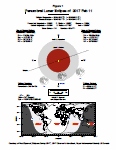![]()
This first lunar eclipse of the year, and the first major astronomical event in 2017, is a penumbral lunar eclipse, the February 11th, 2017 penumbral lunar eclipse. A penumbral lunar eclipse occurs when the Moon is gliding inside the 'penumbra' of the Earth only, instead of the darker 'umbra.' for more about Moon eclipses, theoretically, see our tutorial: Moon Eclipses. A penumbral Moon eclipse, generally, is less spectacular than a total or partial one, as the dimming of the Moon may be harder to observe. It's a good show, worth the observation however. This penumbral lunar eclipse is having the northernmost areas of the Moon passing the closer to the Earth's umbra which will yield a dimming of our satellite there, under the form of a dusky shading
The whole of the eclipse is observable in a area extending from northeastern North America and Brazil to western Central Asia, western Middle East and the whole of Africa (eastern Madagascar excepted). Either side of it, observers will either have the eclipse already encours by moonrise or the eclipse interrupted by moonset. The rest of Americas rank into the first case (with southwestern Alaska having no eclipse) as most of Asia, India and eastern Russia into the second! Japan, eastern Indonesia, Papua-New Guinea, Australia, New Zealand and esternmost Siberia have no eclipse at all (like the western and central Pacific ocean)
The eclipse's main data are the following (data as of November 2016). for more about how to observe a lunar eclipse, see our tutorial 'Observing a Moon Eclipse':
- umbral magnitude (fraction of Moon's diameter immersed in the penumbra at greatest):-0.0354
- greatest eclipse: 00:43:54.0 UT
- eclipse duration (penumbral): 04h19m15s
- eclipse duration (umbral): -
- eclipse contacts (in UT): P1 (penumbral eclipse begins) at 22:34:14, P4 (penumbral eclipse ends) at 02:53:29. No U2 nor U3, neither U1 nor U4 which occur during a total lunar eclipse, or a partial lunar eclipse, respectively only
 | see a .PDF map for the February 11th, 2017 penumbral lunar eclipse (path of the Moon within the Earth's umbra and map of the visibility of the eclipse worldwide). map courtesy Fred Espenak |
. for more about this eclipse and for more about solar and lunar eclipses generally, you may see at the Internet, with Fred Espenak a reference in the domain
Website Manager: G. Guichard, site 'Amateur Astronomy,' http://stars5.6te.net. Page Editor: G. Guichard. last edited: 1/1/2017. contact us at geguicha@outlook.com